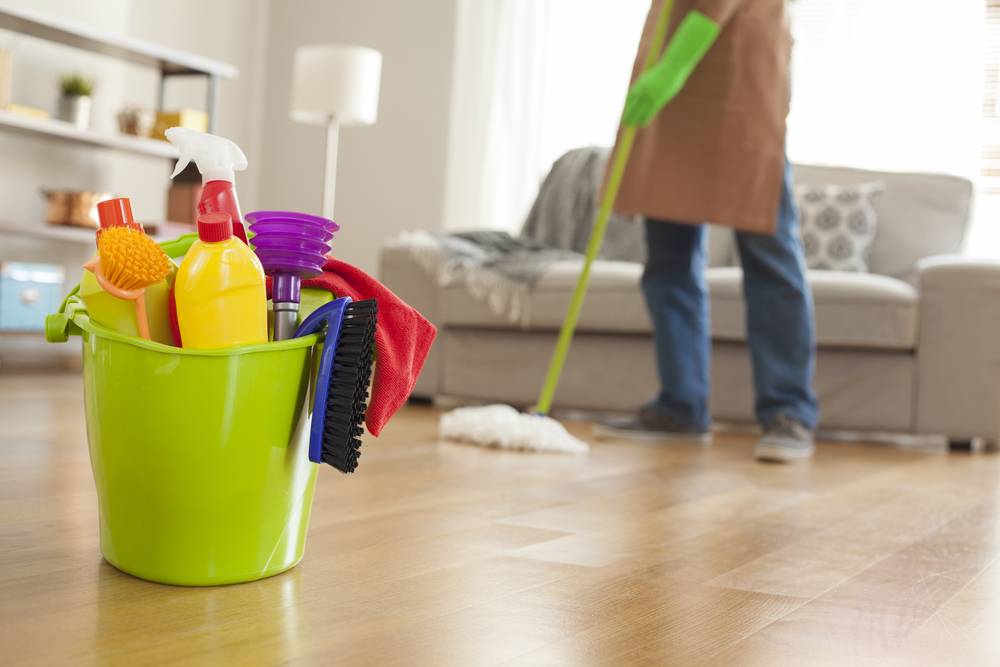Step-by-Step Everyday Cleaning Guide: Specifically How to Scrub the Surfaces, Vacuum Carpets, and Clear Out Any Clutter Effectively
Step-by-Step Everyday Cleaning Guide: Specifically How to Scrub the Surfaces, Vacuum Carpets, and Clear Out Any Clutter Effectively
Blog Article
Understanding the Demand for Extensively Sanitizing and Disinfecting Regularly Touched Surfaces in High-Traffic Areas
In the world of public health and safety, the thorough disinfection and sanitization of often touched surface areas in high-traffic locations stand as critical actions in avoiding the spread of unsafe pathogens. The importance of this method expands far past mere tidiness, diving right into the realm of illness avoidance and area well-being. By exploring the numerous elements of surface area disinfection, from the risks connected with disregarding cleansing procedures to the reliable approaches that can be used, a clearer understanding emerges of the important function these methods play in securing public health and wellness. As we browse this conversation, it comes to be evident that the implications of extensive surface area sanitation resound not just within the confines of a particular setting yet likewise resonate on a wider scale, impacting the health and wellness of individuals across varied common setups.
Relevance of Surface Area Sanitation
Highlighting the thorough sanitation of high-traffic surfaces is crucial in keeping a hygienic atmosphere and stopping the spread of damaging pathogens. High-touch surface areas such as door takes care of, light switches, lift buttons, and kitchen counters act as reproducing grounds for viruses and microorganisms. Regular disinfection of these surfaces is essential to lower the risk of contamination and transmission of ailments.
By applying a robust sanitation protocol, services and institutions can develop a safer atmosphere for site visitors, customers, and employees. Appropriate surface area sanitation not only alleviates the spread of transmittable diseases but also infuses confidence in the cleanliness and security of the facilities. This aggressive technique demonstrates a dedication to health and wellness and health, which is specifically crucial in high-traffic areas where the possibility of exposure to microorganisms is increased.
Additionally, surface area sanitation plays an important function in total infection control approaches. Incorporated with hand health techniques, putting on masks, and maintaining physical distancing, comprehensive sanitation of high-touch surfaces forms a comprehensive protection versus the transmission of unsafe bacteria. Focusing on surface area disinfection is a vital element of a holistic method to health and wellness in common rooms.
Dangers of Ignoring Cleaning Practices
Overlooking thorough disinfection of high-traffic surface areas dramatically enhances the danger of bacterial and viral contamination, posturing a serious threat to the health and wellness of individuals frequenting these spaces. Failure to implement correct cleaning practices can bring about the buildup and spread of dangerous microorganisms, including microorganisms and viruses, on often touched surfaces such as doorknobs, hand rails, elevator switches, and kitchen counters.

In addition, overlooking the significance of thorough cleansing not only endangers the wellness of people however additionally undermines initiatives to preserve a tidy and hygienic atmosphere. It is important to recognize the relevance of correct disinfection methods in avoiding the spread of infections and securing public health.
Reliable Disinfection Techniques
To preserve optimum sanitation and lower the risk of contamination on high-traffic surfaces, using efficient sanitation methods is important. One of the most usual and effective sanitation techniques is utilizing chemical disinfectants.
One more efficient technique is using UV-C light. UV-C light has been shown to be effective in eliminating a wide array of microorganisms by interrupting their DNA framework, therefore avoiding them from duplicating. It is essential to make use of UV-C light appropriately, making sure that the appropriate intensity and direct exposure time are applied to attain the wanted sanitation results.
Furthermore, utilizing vapor cleaning as a disinfection technique can be very efficient, especially on surface areas that are heat-resistant. Steam can penetrate permeable surfaces and eliminate bacteria, viruses, and various other virus effectively. When using steam cleansing, it is important to make sure that the surface reaches the called for temperature for an enough amount of time to ensure proper sanitation.
Effect On Public Health And Wellness
The upkeep of high standards of tidiness and disinfection on high-traffic surface areas plays an essential function in guarding public health. Often touched surface areas in areas with high tramp, such as doorknobs, hand rails, elevator buttons, and bathroom centers, act as reproducing grounds for harmful microorganisms. Falling short to properly disinfect these surfaces can lead to the quick spread of contagious illness within communities. By carrying out thorough disinfection protocols, the danger of transmission of infections, bacteria, and other germs can be substantially lowered.
In high-traffic areas like airports, colleges, medical facilities, and public transportation systems, the influence of extensive sanitation procedures can not be understated. Focusing on the sanitization of frequently touched surface areas is a proactive technique to promoting public wellness and improving the safety and security of individuals in common rooms.
Carrying Out Routine Cleansing Methods
Quickly instituting and sticking to a constant timetable of cleaning procedures is paramount for preserving the sanitation and security of high-traffic surface areas. Regular cleaning methods are vital in stopping the accumulation of bacteria and pathogens on often touched surface areas, specifically in areas with high foot traffic. By applying a methodical technique to cleansing, organizations can efficiently reduce the risk of illness transmission and develop a much healthier environment for workers, consumers, and the public.
To establish an efficient cleansing timetable, it is essential to determine high-traffic areas that need frequent focus. These locations might consist of doorknobs, handrails, elevator switches, bathroom centers, and common tools. Implementing a regular cleansing routine that targets these surface areas numerous times a day can significantly decrease the spread of harmful germs and infections.
In addition, making use of ideal cleaner and anti-bacterials is vital to ensuring that surfaces are extensively disinfected. Normal training of cleansing team on correct cleansing methods and the value of adherence to the cleaning routine is likewise important in maintaining a hygienic setting. By focusing on consistent cleaning protocols, companies can advertise the wellness and well-being of people who connect with these high-traffic surface areas.

Verdict
To conclude, it is essential to prioritize complete sanitation and sanitization of regularly touched surface areas in high-traffic areas to avoid the spread of damaging microorganisms and preserve public health and wellness. Ignoring appropriate cleansing techniques can boost the danger of contamination and transmission of illness. By carrying out routine cleaning methods and using reliable sanitation techniques, we can produce a safer environment for everyone (Scrub the Surfaces). It is necessary to identify the relevance of preserving clean surface areas in high-traffic locations to make sure the well-being of the community.
In the realm of public wellness and safety, the thorough disinfection and sanitization of regularly touched surfaces in high-traffic locations stand as extremely important actions in avoiding the spread of hazardous virus. By checking out the numerous elements of surface sanitation, from the risks connected with overlooking cleaning methods to the effective techniques that can be employed, a clearer understanding arises of the vital function these practices play in guarding public health.Furthermore, using steam cleaning Clear Out Any Clutter as a sanitation method can be extremely efficient, especially on surfaces that are heat-resistant. When utilizing vapor cleansing, it is vital to ensure that the surface gets to the needed temperature level for a sufficient amount of time to ensure correct sanitation.
In conclusion, it is critical to focus on detailed disinfection and sanitization of frequently touched surfaces in high-traffic locations to protect against the spread of harmful pathogens and preserve public health and wellness.
Report this page